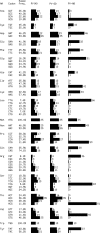Reduction of the rate of poliovirus protein synthesis through large-scale codon deoptimization causes attenuation of viral virulence by lowering specific infectivity
- PMID: 16973573
- PMCID: PMC1617239
- DOI: 10.1128/JVI.00738-06
Reduction of the rate of poliovirus protein synthesis through large-scale codon deoptimization causes attenuation of viral virulence by lowering specific infectivity
Abstract
Exploring the utility of de novo gene synthesis with the aim of designing stably attenuated polioviruses (PV), we followed two strategies to construct PV variants containing synthetic replacements of the capsid coding sequences either by deoptimizing synonymous codon usage (PV-AB) or by maximizing synonymous codon position changes of the existing wild-type (wt) poliovirus codons (PV-SD). Despite 934 nucleotide changes in the capsid coding region, PV-SD RNA produced virus with wild-type characteristics. In contrast, no viable virus was recovered from PV-AB RNA carrying 680 silent mutations, due to a reduction of genome translation and replication below a critical level. After subcloning of smaller portions of the AB capsid coding sequence into the wt background, several viable viruses were obtained with a wide range of phenotypes corresponding to their efficiency of directing genome translation. Surprisingly, when inoculated with equal infectious doses (PFU), even the most replication-deficient viruses appeared to be as pathogenic in PV-sensitive CD155tg (transgenic) mice as the PV(M) wild type. However, infection with equal amounts of virus particles revealed a neuroattenuated phenotype over 100-fold. Direct analysis indicated a striking reduction of the specific infectivity of PV-AB-type virus particles. Due to the distribution effect of many silent mutations over large genome segments, codon-deoptimized viruses should have genetically stable phenotypes, and they may prove suitable as attenuated substrates for the production of poliovirus vaccines.
Figures





References
-
- Cello, J., A. V. Paul, and E. Wimmer. 2002. Chemical synthesis of poliovirus cDNA: generation of infectious virus in the absence of natural template. Science 297:1016-1018. - PubMed
Publication types
MeSH terms
Substances
Grants and funding
LinkOut - more resources
Full Text Sources
Other Literature Sources
Medical

